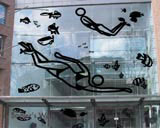Out of site
Artist Julian Opie explains to Sara Manuelli how nothing inspires his work

Julian Opie is a busy man. Tomorrow sees the opening of two different site-specific installations, one at Sadler’s Wells Theatre in London and another at Selfridges Exchange Square, Manchester. Meanwhile, London St Barts Hospital has also unveiled an oversized Opie canvas, as part of an arts project that will run parallel to the development of a new breast care centre.
Opie seems bemused by the timing, which probably owes more to projects’ deadlines shifting than a well-planned strategy to take over the world, but he admits he might have acquired a reputation for someone who ‘can deliver’, even within unconventional spaces.
The Sadler’s Wells exhibition, Underwater, will feature large-scale images of vinyl swimmers and fish applied directly to the glass facia and side windows of the theatre. ‘I quite like the idea of the architecture being the structure that holds the image,’ says Opie, who admits that he thinks of large-scale projects more like sculpture than painting. ‘The canvas becomes part of the work, whereas normally you’re asked to ignore that it’s there,’ he says.
For Sadler’s Wells, Opie was given an open brief and a chance to continue themes – people swimming, fish, water and working on glass – that are currently informing his work. As he explains it, the water theme, which Opie has painted often, is ‘using that idea that when you draw water, you are drawing a lot, but actually there is a sense you are drawing nothing. So it’s actually very complicated, although there is a sense it’s nothing, just like a road might be nothing. And I’m interested in nothing.’ As for the structure of the theatre, ‘the glass allows me to float images in space. Glass is something that is used a lot in modern architecture, but not so much in art, so it gives me enormous scope without getting into anyone’s way,’ he says.
The Selfridges project, a collaboration with Marks & Spencer, also makes use of a large glass facia on Exchange Square in Manchester. The artwork, entitled Walk, Walk, Walk, features two large-scale figures, a man and a woman, moving across the retail space and eventually meeting in a jumbled embrace. ‘It’s about reflecting the business of people walking in all directions,’ says Opie.
A contrast to the frenetic pace of the Manchester installation is the St Barts 18m by 50m landscape, a variation of Opie’s signature motorway paintings. Entitled I dreamt I was driving in my car (country road 2002), it may seem an odd choice for a women’s breast cancer unit. Yet, as Opie points out, he avoided talking directly about illness or cancer since his work isn’t about those themes. ‘I’m offering people another place to be,’ he says, and i
n this case, the place is the depiction of a B road off the M1 motorway, which he frequents on the way to Luton to pick up his Swiss wife and relatives.
‘The motorway is a reflection of existence in a modern way,’ Opie says. ‘It has a similarity [in classic painting] to the notion of a vista. [John] Constable and [Thomas] Gainsborough used the road in their paintings, there is always a cart track or a path that leads you into the picture. It’s a great trick,’ he says. In this context, ‘it’s a mix between ideal, pastoral “boringness” and road imagery. Since cars are usually parked in front of the canvas they become part of the setting, and the claustrophobic courtyard opens out into an enormous vista of a very empty, bland English landscape.’ An offer of escapism that aims to lift the patients’ morale
-
Post a comment



